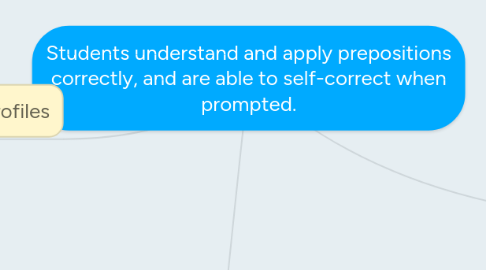
1. Learning Profiles
1.1. Individual Learning
1.1.1. There is a simple truth that some students need one to one time with their teach in order to understand and appreciate concepts. Whether due to specific learning needs or personality differences, it is important to take into account this need.
1.1.1.1. Give students the time to complete work on their own. It's important to have a time limit for activities, but some students in my class are easily stressed if I keep checking up on them. Give them the work and then step back and only talk to them when they're finished or the time is up.
1.1.1.2. Pre-write sentences for students who struggle with fine motor skills. Write a sentence with crayon and then get the student who struggles to write over it with their pencil.
1.2. Group Work
1.2.1. As true as it is that some students work best on their own, it is also true that some students need the support and teamwork that comes with work in a group.
1.2.1.1. Divide the students up into small groups of three. Try and mix students with different skills. If a student who is confident in writing, try and put them with someone who is maybe more confident in speaking.
1.2.1.2. Also try to blend personalities, if you have a student who tends towards being "silly" in the classroom, try and pair them up with a student who can help them stay on task.
2. Interests
2.1. Making things interesting and relateable is extremely important for young learners as they generally have very short attention spans!
2.1.1. Sports and Games. It's not necessarily easy to use Soccer as a teaching method, but getting the class up and moving is a great way to keep them interested.
2.1.2. It's been said many times, but children learn best when they don't even realise they're learning!
2.1.3. STAR WARS! I have a class of 9 boys and Star Wars is the best thing ever in my class right now, if I could use some examples that include Star Wars then I'm sure to win then over.
3. Readiness Levels
3.1. Reading
3.1.1. With Kindergarten age children will have to take into account the question of whether or not children can actually read or not.
3.1.1.1. There's no point in giving written instructions if they can't read them!
3.1.1.2. Give instructions verbally and reinforce with visual examples as necessary.
3.1.1.3. When writing is needed, keep it short and don't pick out students I know can't read, Ask students who are more confident in reading to help!
3.2. Writing
3.2.1. Some students have difficulty when it comes to writing. Whether it's due to issues with motor skills, or simply that they're slow to pick it up, it's important to keep writing down to a minimum.
3.2.1.1. Keep writing tasks short. Even 5 year olds who can write well will quickly lose interest if the tasks are dragging on.
3.2.1.2. For students who struggle with motor skills, give them guidelines to follow rather than writing it on their own.
